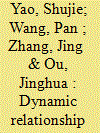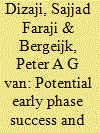| Srl | Item |
| 1 |
ID:
147614


|
|
|
|
|
| Summary/Abstract |
This paper studies the dynamic relationship of China's inward and outward foreign direct investments (FDI). It first identifies the key determinants of China's outward FDI (OFDI) in 172 host countries during 2003–2009 using a partial stock adjustment model. It finds strong evidence of dynamic adjustment in China's OFDI stock with an agglomeration effect. The dynamic adjustment and agglomeration effects are stronger in “high-tech” countries than in “low-tech” ones but indifferent in host country's resource endowments and income levels. The empirical results suggest that there exists a substantial adjustment cost in China's OFDI and that China's existing OFDI stock can gradually adjust toward its long-term equilibrium level, which is not only greater but also more volatile than the actual stock. Of particular interest is that we find a strong and positive relationship between lagged inward FDI (IFDI) and contemporaneous OFDI, implying that capital outflow from China has been partially induced by the countries which have invested in China.
|
|
|
|
|
|
|
|
|
|
|
|
|
|
|
|
| 2 |
ID:
131398


|
|
|
|
|
| Publication |
2014.
|
| Summary/Abstract |
The paper considers the optimal transition path for China's exchange rate regime. How can China successfully make the shift from the current dollar peg regime to a more desirable regime, whether a basket peg or a floating regime? To answer this question, we develop a dynamic small open economy general equilibrium model. We construct four transition policies based on a basket peg or a floating regime and compare the welfare gains of these policies relative to maintaining the dollar peg regime. Two main results are derived from the quantitative analysis using Chinese data from 1999Q1 to 2010Q4. First, following a gradual adjustment to a basket peg regime is the most appropriate path for China to take, with minimal welfare losses associated with the shift in the exchange rate regime. Second, a sudden shift to the basket peg is the second best solution, and is superior to a sudden shift to floating because the monetary authority can efficiently determine optimal weights to attach to currencies in the basket to achieve policy goals once they adopt a basket peg regime.
|
|
|
|
|
|
|
|
|
|
|
|
|
|
|
|
| 3 |
ID:
124984


|
|
|
|
|
| Publication |
2013.
|
| Summary/Abstract |
In order to explain why successes of economic sanctions predominantly occur in the first two years of a sanction episode, we analyse the dynamic economic and political impact of an economic sanction. Our theoretical analysis of the dynamics of adjustment gives us two important results: firstly, the strongest impact in terms of utility forgone occurs in the initial phase of the sanction episode and, secondly, the long-term gain of compliance decreases during a sanction episode and is lower in the long run than acknowledged by the usual comparative static analysis. On both accounts we expect that sanctions have a higher probability of success in the early phase and a lower probability of success in the long run. Next we build a comprehensive set of vector autoregressive (VAR) models that we apply to the case of a boycott of Iranian oil. An important innovation is that we include both economic and political factors in a VAR model of economic sanctions. Our VAR models find significant impacts of economic sanctions both on key economic variables (government consumption, imports, investment, income) and on two indicators of the political system (the Polity variable that describes shifts in the autocracy-democracy dimension and the Vanhanen Index of Democratization that describes political competition and participation). The impact of an oil boycott on the Iranian economy is considerable: oil and gas rents are important drivers of the Iranian key macroeconomic variables and ultimately of its political system. A reduction of oil and gas rents creates economic costs that act as incentives to move towards a more democratic setting. However, this effect is only significant in the first two years and turns negative after six to seven years, as adjustment of economic structures mitigates the economic and political impact of the sanctions.
|
|
|
|
|
|
|
|
|
|
|
|
|
|
|
|